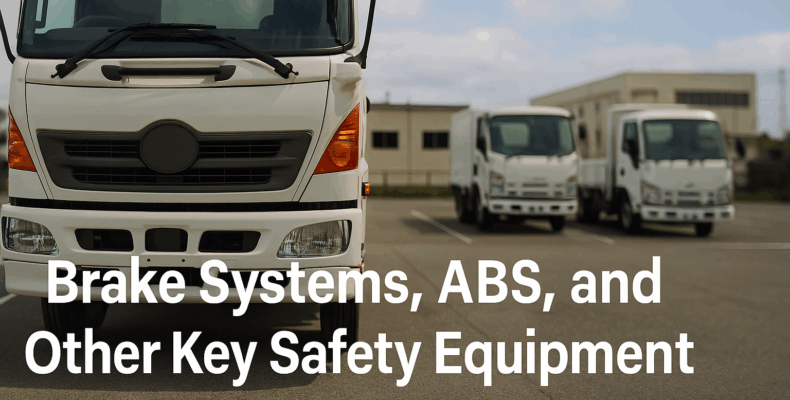Brake Systems, ABS, and Other Key Safety Equipment
Safety is one of the most critical aspects when operating Japanese used trucks. Whether you are transporting goods across busy city streets or navigating challenging rural roads, reliable braking systems and advanced safety features can mean the difference between smooth delivery and serious accidents.
In this guide, we will explore the essential brake technologies—such as Anti-lock Braking Systems (ABS)—alongside other crucial safety equipment. We will also explain how working with trusted exporters ensures you get a truck with top-tier safety performance.
1. The Importance of Strong Brake Systems
Japanese trucks are renowned for their durable and efficient braking systems. These systems are engineered to handle heavy loads and frequent stops without compromising safety. Common brake types in Japanese trucks include:
-
Air Brakes: Used in heavy-duty models for consistent stopping power.
-
Hydraulic Brakes: Common in light and medium-duty trucks for smooth operation.
-
Disc and Drum Combinations: Designed to balance cost, durability, and performance.
Routine maintenance—such as checking brake pads, adjusting brake drums, and inspecting brake lines—is essential to ensure optimal performance.
2. ABS: Anti-lock Braking System
ABS prevents the wheels from locking during sudden braking, helping the driver maintain steering control. This is especially important in wet, icy, or loose-surface conditions.
In Japanese trucks, ABS is often paired with Electronic Brakeforce Distribution (EBD) to deliver balanced stopping power across all wheels. This combination reduces the risk of skidding, shortens stopping distances, and increases driver confidence.
3. Other Key Safety Equipment
Beyond braking systems, modern Japanese trucks are equipped with additional safety features:
-
Electronic Stability Control (ESC): Helps prevent rollovers and skidding.
-
Lane Departure Warning Systems: Alerts the driver if the truck drifts unintentionally.
-
Collision Mitigation Systems: Uses sensors to apply brakes automatically in emergencies.
-
Rearview Cameras and Proximity Sensors: Improves visibility and reduces blind spots.
4. Why Japanese Safety Standards Are Trusted Worldwide
Japanese manufacturers like Isuzu, Hino, Mitsubishi Fuso, and Toyota design trucks to meet strict national safety regulations. These standards often exceed those in many importing countries, which is why Japanese trucks are highly valued globally.
5. Partnering with Reliable Exporters
When purchasing a used Japanese truck, it is essential to work with exporters who verify that all safety systems are functional. We recommend the
Top 5 Trusted Japanese Used Truck Exporters for Global Buyers.
These Japan-based companies provide thorough inspections, transparent reports, and secure shipping so that you receive a truck with dependable safety equipment.
6. Tips for Buyers
-
Request Safety Inspection Reports: Confirm that brakes, ABS, and other features work properly.
-
Check Maintenance History: Well-maintained trucks retain their safety performance for longer.
-
Test Before Shipping: If possible, arrange a pre-export test drive to assess brake responsiveness.
Conclusion
A truck’s value is not just in its carrying capacity or fuel efficiency—it’s also in its ability to keep the driver, cargo, and other road users safe. By prioritizing strong brake systems, ABS, and other advanced safety features, you can ensure both performance and peace of mind.
Before making a purchase, always connect with trusted Japanese exporters, such as those listed in the
Top 5 Trusted Japanese Used Truck Exporters for Global Buyers, to secure a safe and reliable vehicle for your business.
